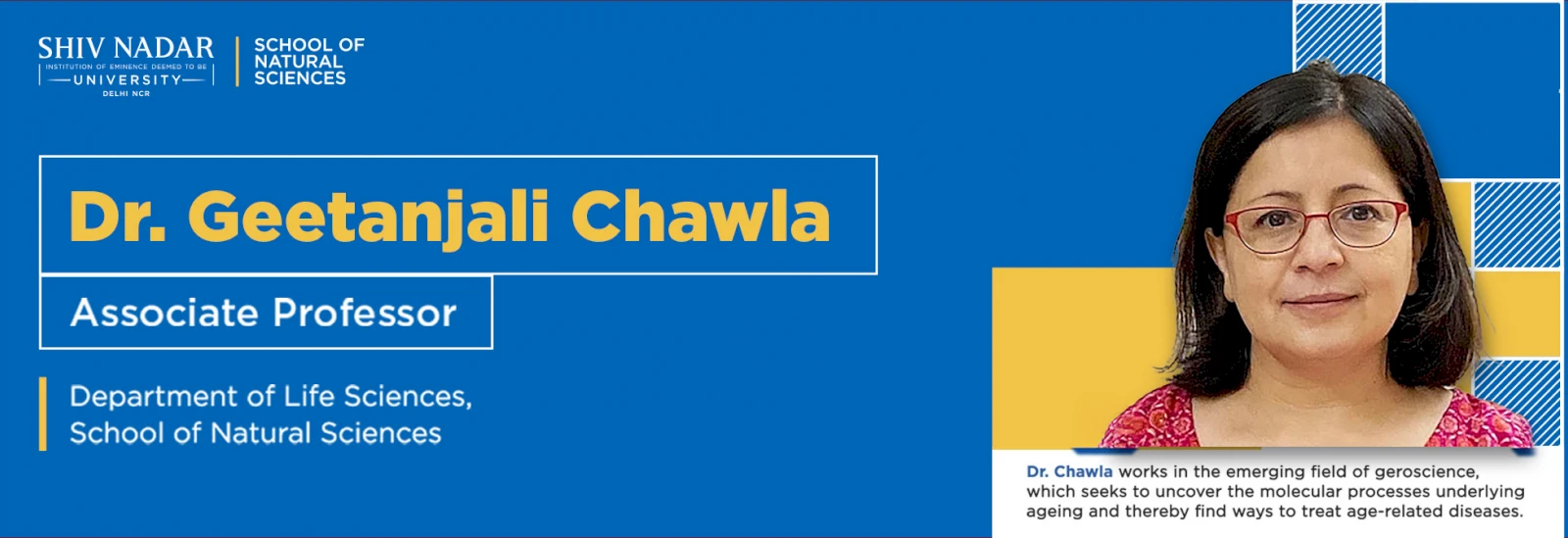The Molecular Science of Ageing: How Nutritional Interventions Can Improve Health
Ageing is inevitable, but does illness have to be?
In 2024, the National Council on Aging in the US reported that nearly 95% of adults over the age of 65 live with at least one chronic illness. In India, similar research shows that about 28% of older adults suffer from multiple chronic illnesses. As we grow older, we become more susceptible to cardiovascular diseases, diabetes, Alzheimer’s disease, chronic respiratory disease, and so on. This is where the field of geroscience comes in.
“The goal of a geroscientist is to develop interventions that can not only slow down ageing, but that can also be used for treatment of these age-related conditions,” explains Dr. Geetanjali Chawla, an Associate Professor at the Department of Life Sciences, School of Natural Sciences, who is at the forefront of developing the field in India. While many researchers focus on the cellular and molecular mechanisms behind individual diseases, geroscience takes a broader view—seeking to understand the fundamental processes that drive ageing itself, with the goal of targeting multiple age-related illnesses by slowing down the ageing process.
Dr. Chawla’s work focuses on nutritional geroscience or nutrigeroscience—slowing down ageing through nutritional interventions like dietary restriction.
Dietary restriction refers to reducing food intake without incurring malnutrition. A common dietary restriction that has been studied across several animal models with reproducible benefit is calorie restriction. But dietary restriction as a concept is not limited to just that; it also extends to limiting amounts of specific macronutrients, limiting intake to specific hours of the day etc. According to Dr. Chawla, “Three major ways in which I think dietary restriction causes health enhancement is through increased lifespan, improved mitochondrial function, and reduced senescent cells.” The latter two are a result of reduced oxidative stress in the body. Senescent cells are ageing cells in the body that no longer divide. These senescent cells cause inappropriate immune responses in the body, such as inflammation.
Presently, there is a lot of interest in dietary restriction mimetics—molecules that can target cellular processes and mimic the action of dietary restriction without the individual needing to follow a restricted diet. Another direction of research is precision nutrigeroscience, which investigates the various biomarkers associated with ageing and tracks the impact of dietary restriction through these biomarkers on different subgroups of the population, such as different genders, ages, etc.
Two such biomarkers that Dr. Chawla has connected to the ageing process are the microRNAs (miRNAs) let-7 and miR-125. miRNAs are non-coding RNAs that attach to mRNAs to regulate the expression of different proteins. Dr. Chawla found that these two miRNAs are involved in the regulation of a protein called Chronologically Inappropriate Morphogenesis (Chinmo). “A major finding from that study was that although these two miRNAs are co-transcribed, they influence different processes at different stages of the life span of Drosophila melanogaster (fruit fly),” explains Dr. Chawla. “This shows that you can’t just suppress one miRNA from birth and expect it to have an anti-ageing effect. You need to target the right gene at the right time.”
One of the major considerations when targeting miRNAs is ‘differential processing.’ Differential processing is peculiar to clustered miRNAs, which are different miRNAs that are expressed from the same parent gene. These miRNAs are expressed in different amounts in different types of cells at different ages, which means that the impact they have on gene regulation also varies. This phenomenon is called differential processing. “Understanding why you get different miRNAs from the same parent gene in different copy numbers (amounts) will help in developing strategies to change the levels of these miRNAs without actually changing the sequence of the mature miRNA, and thereby influence ageing-related processes,” clarifies Dr. Chawla.
Dr. Chawla’s research has revealed that miR-125 levels in fruit flies can be altered through dietary restriction. In particular, miR-125 affects lipid metabolism through the expression of the chinmo protein. “This miRNA essentially mimics the effect of dietary restriction, so it can be used as a dietary restriction mimetic. It can also be used as a biomarker for healthy ageing in humans,” she adds.
For her work, Dr. Chawla has won a DBT-Wellcome India Alliance Intermediate Fellowship in 2018 and the SERB-CRG grant in 2024. Currently, her lab is investigating the impact of auxiliary miRNA biogenesis factors on ageing and age-related diseases. For example, two of her Ph.D. students are investigating the role of miRNAs and genetic variants involved in the development of depression and anxiety-like behaviour (anxiety and depression is more common in elderly women than men).
We look forward to seeing what Dr. Chawla discovers next!
